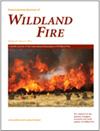Fighting fire and fumes: risk awareness and protective practices among Western Australian firefighters
IF 2.9
3区 农林科学
Q1 FORESTRY
引用次数: 0
Abstract
Background In Western Australia, the issue of bushfires (wildfires) poses a persistent health risk to both volunteer and career forestry firefighters, populations that have been historically understudied. Aims This descriptive qualitative study aimed to examine firefighters’ level of understanding concerning hazardous exposures, their Personal Protective Equipment (PPE) protocols and their decontamination practices. Methods Guided by the socioecological model, 23 semi-structured interviews were conducted with firefighters representing both volunteer and forestry sectors. Key results Results indicate a gap in knowledge regarding the health risks associated with bushfire-generated smoke and contaminants among volunteer firefighters. Forestry firefighters, conversely, showed a greater awareness of these risks. Social dynamics, such as peer pressure, were identified as historical deterrents to PPE use, although recent trends indicate positive change. Forestry firefighters also highlighted systemic shortcomings, including inadequate provision of respiratory protection and lack of decontamination facilities for cleaning themselves and their PPE. Conclusion This study underscores the critical need for educational initiatives to address these gaps in understanding, along with organisational reforms to promote a culture encouraging PPE use and to provide essential resources for effective decontamination. Implications This research emphasises that a multi-level approach is essential for safeguarding the health of firefighters in bushfire-prone environments.灭火与烟雾:西澳大利亚消防员的风险意识和保护措施
背景 在西澳大利亚,丛林火灾(野火)问题对志愿和职业森林消防员构成了持续的健康风险,而对这些人群的研究历来不足。目的 这项描述性定性研究旨在考察消防员对危险暴露的了解程度、他们的个人防护装备 (PPE) 协议以及他们的净化做法。研究方法 以社会生态模型为指导,对志愿消防员和林业消防员进行了 23 次半结构式访谈。主要结果 结果表明,志愿消防员对丛林火灾产生的烟雾和污染物所带来的健康风险缺乏了解。相反,森林消防员对这些风险的认识则更为深刻。同伴压力等社会动力被认为是阻碍使用个人防护设备的历史原因,尽管最近的趋势表明已经发生了积极的变化。森林消防员还强调了系统性缺陷,包括呼吸保护装置提供不足以及缺乏用于清洁自身和个人防护设备的净化设施。结论 本研究强调,亟需采取教育措施来解决这些认识上的差距,同时进行组织改革,以促进鼓励使用个人防护设备的文化,并为有效净化提供必要的资源。启示 本研究强调,多层次的方法对于保障丛林火灾易发环境中消防员的健康至关重要。
本文章由计算机程序翻译,如有差异,请以英文原文为准。
求助全文
约1分钟内获得全文
求助全文
来源期刊
CiteScore
5.50
自引率
9.70%
发文量
67
审稿时长
12-24 weeks
期刊介绍:
International Journal of Wildland Fire publishes new and significant articles that advance basic and applied research concerning wildland fire. Published papers aim to assist in the understanding of the basic principles of fire as a process, its ecological impact at the stand level and the landscape level, modelling fire and its effects, as well as presenting information on how to effectively and efficiently manage fire. The journal has an international perspective, since wildland fire plays a major social, economic and ecological role around the globe.
The International Journal of Wildland Fire is published on behalf of the International Association of Wildland Fire.

 求助内容:
求助内容: 应助结果提醒方式:
应助结果提醒方式:


